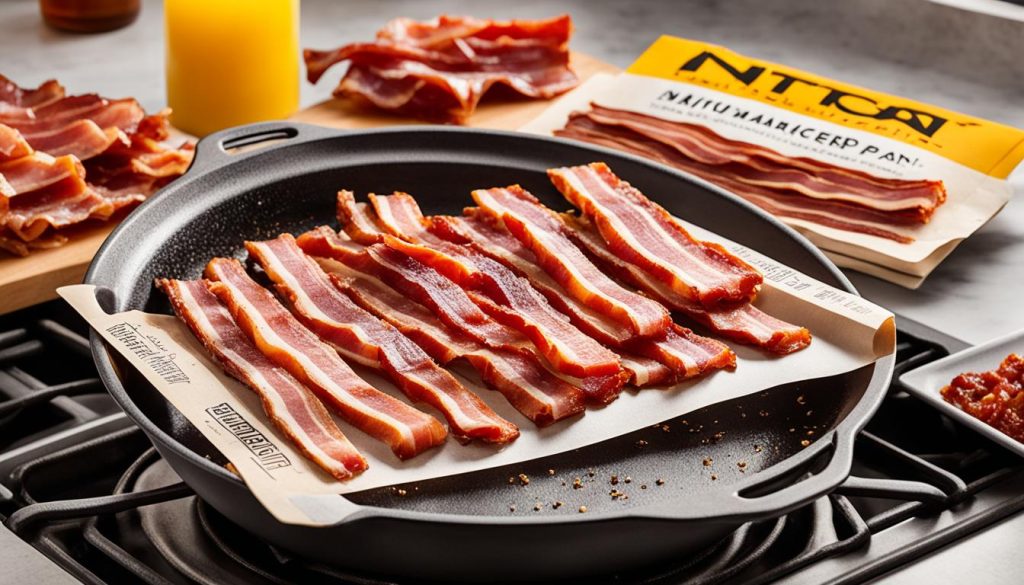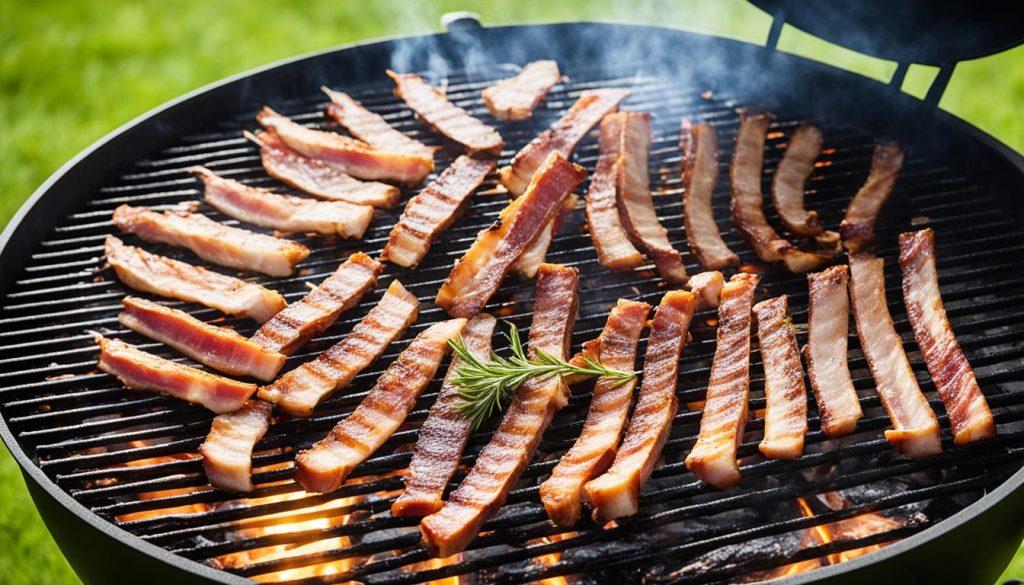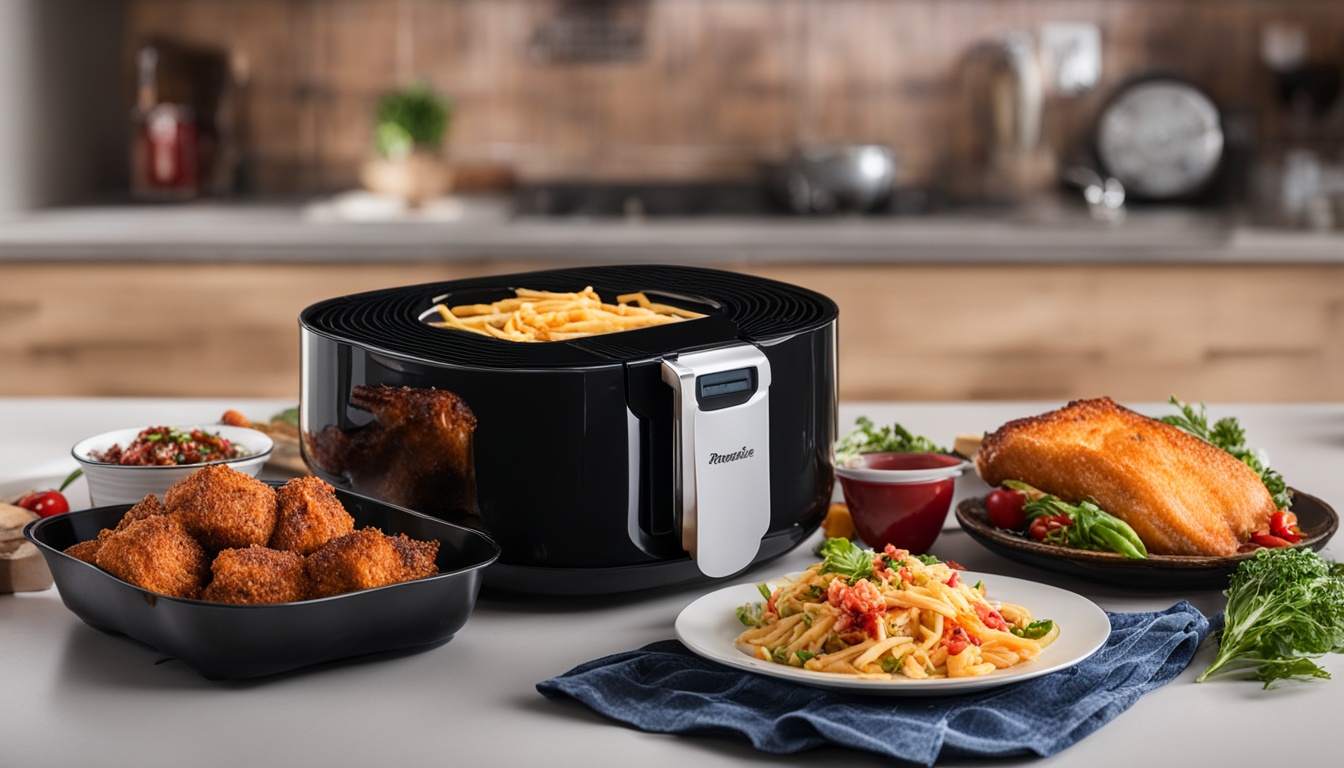Did you know 43% of Americans love crispy bacon more than chewy? This shows the need to know how to cook bacon just right. Whether you’re new to cooking or a bacon pro, getting the perfect taste and texture in uncured bacon is fun. You can cook it on a stovetop, in an oven, or on a grill. Each way needs special attention to avoid mistakes and make this treat even better. Let’s look at how to make your uncured bacon taste amazing.
Key Takeaways
- Start with a cold pan to render fat evenly.
- Avoid overcrowding your pan for uniform cooking.
- Use a lined rimmed baking sheet when oven-baking for easy cleanup.
- Utilize indirect heat on the grill to prevent burning.
- Monitor your cooking time to achieve the desired crispness.
Understanding Uncured Bacon
Uncured bacon stands out because of how it’s kept fresh. Unlike cured bacon, it doesn’t use artificial preservatives. Instead, it gets its freshness from natural nitrates found in celery powder or sea salt. Knowing this is key to appreciate the special taste and texture of uncured bacon.
What is Uncured Bacon?
Don’t let the name fool you, uncured bacon is still preserved. But it’s done using methods that skip the synthetic stuff. Natural ingredients are used instead of the usual additives. This keeps it fresh and gives it a unique taste.
How Does It Differ from Cured Bacon?
The big difference between cured and uncured bacon is in the preserving agents. Cured bacon relies on artificial sodium nitrate. However, uncured bacon uses natural items like celery powder and sea salt. This change not only affects the flavor but also makes it a healthier pick by avoiding artificial chemicals.
Health Benefits of Uncured Bacon
Opting for uncured bacon could have health perks. Without artificial nitrates, you’re cutting down on harmful additives. Instead, it’s preserved naturally, like with celery powder. This means it might be a better choice for health-conscious eaters.
When you’re cooking uncured bacon, how it’s preserved makes a big difference. It affects not just the taste but also how it feels when you eat it. Whether it’s for health or flavor, uncured bacon is a tasty and wholesome choice.
Choosing the Best Uncured Bacon
Finding the best uncured bacon starts with the labels. You want a product that’s truly free from artificial nitrates or nitrites. Look for labels that say “no added nitrates or nitrites.” Also, make sure natural preservatives like celery powder or sea salt are listed.

What to Look for on the Label
Knowing what’s on the package is crucial for cooking uncured bacon. Look for:
- “No added nitrates or nitrites”
- Naming natural preservatives such as celery powder or sea salt
- Details about the curing process indicating minimal processing
Reading labels well means you’re choosing a natural, healthier bacon. This is a vital part of any guide to cooking uncured bacon.
Top Recommended Brands
Choosing the right brand can make a big difference. Some top brands for quality uncured bacon are:
- Trader Joe’s Black Forest Bacon
- Applegate Naturals Uncured Bacon
- Niman Ranch Uncured Bacon
These brands are known for their taste, the right fat-to-meat balance, and using natural preserving methods. Having them in your kitchen can really improve your cooking. They make your meals taste better. Remember these tips when looking for uncured bacon.
Preparation Tips for Cooking Uncured Bacon
Preparing uncured bacon right is key for perfect taste and texture. It’s all about the prep.
Proper Storage
Keep your uncured bacon in the coldest spot in your fridge. This helps it last longer and cook better. Want to store it for a while? Freeze it well in an airtight bag or container to stay fresh. This step prevents the bacon from getting freezer burn.
Prepping Your Bacon
Getting your uncured bacon ready is a big deal. For baking it, you might want to use a wire rack. This way, the bacon gets crispy because the fat drips off. Just make sure not to let the strips overlap on the rack. This will help them cook evenly. For stovetop or grill cooking, lay out the bacon in a single layer. It makes the whole cooking thing smoother.
Knowing how to prep makes cooking uncured bacon perfect every time. You end up with tasty, crispy bacon.
Stovetop Method: Perfecting Your Technique
Learning to cook bacon perfectly on the stovetop takes practice. For uncured bacon, knowing the right moves means you’ll get great-tasting bacon every time. It’s all about the method when it comes to the stovetop.
Starting with a Cold Pan
Though hearing the sizzle right away seems fun, starting cold is better. It lets the bacon’s fat melt slowly and evenly. This makes the bacon turn out just right. Make sure the bacon’s not crowded and can lay flat.
Managing Heat Levels
Setting the right heat is key for good stovetop bacon. Begin with medium heat to warm everything up smoothly. This stops the bacon from being too crispy on the outside but raw inside. Adjust the heat if it’s cooking too fast; steady sizzling is what you need.
Tips for Ensuring Crispiness
For extra-crispy bacon, keep a few tips in mind to get the texture right without losing taste. Don’t pack the bacon in the pan. Flipping occasionally with tongs helps evenly cook each piece. As you near the end, remove the extra fat and let it drain on paper towels. This extra step keeps your bacon nice and crispy.
Oven Method: Cooking Uncured Bacon for Perfect Results Every Time
If you want your bacon to turn out perfect and mess-free, bake it in the oven. This method makes cooking bacon easy. It gives you a setting where you can be sure your bacon will come out right each time.
To start, heat your oven to 400°F. While it warms up, cover a baking sheet with parchment paper or foil. This makes clean up easy and helps cook the bacon evenly. For extra crispy bacon, put a wire rack on your baking sheet. It lets air move around the bacon, making it extra crispy.
Put the bacon slices in a single layer on the baking sheet, without letting them touch. Even cooking needs the right space. Pop the sheet in the oven and set a 10-minute timer. Watch closely to avoid overcooking. Every oven is different, so you might need to tweak the time a bit. If you use a wire rack, the bacon might cook faster.
This oven-made bacon doesn’t need to be flipped. But watch it carefully, especially near the 10-minute mark. Start checking to see if it’s done. You might need to cook it longer for the perfect crisp.
The oven method makes making bacon simple yet perfect. It beats the mess of stovetop cooking. Plus, you get bacon cooked just right every time with little work.
Grilling Uncured Bacon for Outdoor Cooking
Bringing uncured bacon outside for grilling gives a special joy in cooking. The smell of bacon roasting outside is hard to resist. Yet, getting the cooking just right needs some key steps.

Using Indirect Heat
When grilling uncured bacon, indirect heat is a must. Put the bacon on the cooler grill side. This way, it cooks slowly and evenly. Also, it makes sure the fat drips off without causing fires.
Tips for Campfire or Grill Cooking
For those at a campfire, a grill grate over hot coals is perfect. But first, lay down aluminum foil on the grate. This stops the bacon from sticking and makes cleanup easier. Don’t forget to keep an eye on the bacon and move it around to cook evenly.
Crisping Over Open Flame
To finish, crisp the bacon over direct flame just before it’s ready. This brings out its crunch and adds a smoky taste. Doing this step just right makes your grilling uncured bacon truly perfect.
Common Mistakes to Avoid
Cooking uncured bacon might seem easy, but it’s not. Several common mistakes can mess it up. Knowing what to avoid helps make your bacon perfect every time.
Overlapping Slices
One common mistake is putting bacon slices on top of each other in the pan. This makes the bacon cook unevenly. It also causes the bacon to get a chewy texture instead of being crispy. Always lay your bacon out in a single layer for better results.
Using Too Much Heat
Using too much heat is another big mistake. This leads to bacon that’s burnt outside but raw inside. To cook bacon well, use medium heat. This lets the fat in the bacon cook off slowly, making it crispy all over.
Not Monitoring Cooking Time
Not keeping an eye on the cooking time can burn your bacon fast. No matter where you’re cooking it, watch the clock. Bacon can turn from perfect to burnt in seconds. So, focus on the time to cook it just right.
Avoiding these mistakes ensures your bacon is always crispy and tasty. Remember to organize the slices well, control the heat, and watch the time. This way, your bacon will turn out great every time.
Conclusion
The journey to mastering uncured bacon takes patience and careful steps. By following our tips and avoiding common mistakes, you’ll make great bacon every time. You can cook it outdoors for a smoky taste or bake it for a crispy finish.
Cooking perfect uncured bacon is all about the details. It’s important not to rush, to use the right tools, and to control the heat well. Make sure to cook each slice well and notice the unique taste and texture of uncured bacon.
Now, it’s your chance to perfect these cooking methods to your liking. The knowledge and advice are here for you to use. Enjoy your bacon cooked just how you like it, whether chewy or crispy. Remember, cooking with confidence and care makes amazing uncured bacon.











